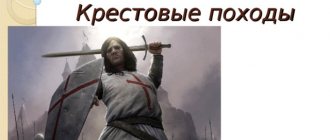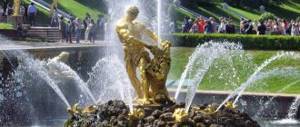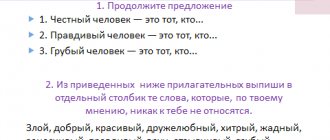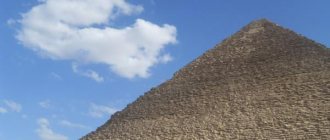Religious beliefs in ancient Egypt
The Egyptians' attitude to religion was special, which also influenced their daily life.
The best birthday gift for an Egyptian was not money or precious things, or even weapons. The best gift was a sarcophagus, which guaranteed the birthday boy a dignified stay in the Kingdom of the Dead.
The ancient Egyptians believed that they could influence their lives through cults. They attached sacred meaning to even small signs and regarded them as fateful signs. In ancient Egyptian houses there was an altar, near which prayers were held to the gods, and temples were considered the abode of heavenly shrines. In their honor, sacrifices were made and various celebrations were held.
A feature of the religion of the ancient Egyptians was a unique attitude towards the afterlife. It was presented as an eternal continuation of life on Earth.
Every pharaoh prepared for his afterlife from birth. This fact is confirmed by religious burials, where a huge amount of things needed in the afterlife were left next to the deceased.
A kind of “Bible” of the ancient Egyptians is the Book of the Dead. It describes the fate of man at the Judgment of Osiris and the subsequent afterlife.
TOP 4 articles that are read along with this
- 1. Gods of Ancient Egypt
- 2. Myths of Ancient Egypt
- 3. Pharaohs of Ancient Egypt - list and description
- 4. Bible stories (5th grade)
Rice. 1. The Judgment of Osiris.
Speaking briefly about religious beliefs in Ancient Egypt, it should be noted the number of revered gods - there were about 5000 of them. Initially, when Ancient Egypt was not yet united under the rule of one pharaoh, who was considered the deputy of the gods on Earth, almost every city had its own supreme god, but gradually the pantheon of gods acquired a single standard.
The first pharaohs in Ancient Egypt were considered gods, and their father was the god Amun-Ra (or simply Ra).
The sun was seen as a symbol of immortality and cyclical rebirth. Man was two-in-one and therefore, for the afterlife, he had to preserve, in addition to his soul, his body. This led to the emergence of the ritual of mummification and the construction of first mastabas (truncated pyramids), and then stepped and smooth pyramids.
Rice. 2. Pyramid of Djoser.
Gods in Ancient Egypt were depicted as humans with animal body parts. The most revered were the cat, lion, jackal, ibis, and crocodile. From here the gods Osiris, Isis, Bastet, Horus, Set, Anubis and others arose. Each god had his own set of functions and had his own area of responsibility.
Rice. 3. God Horus.
Over thousands of years, the religious system has gone through a great process of formation and correction. Even after Akhenaten’s religious reform, which led to monotheism, the Egyptians were unable to accept the new way of life and after the death of the pharaoh the reform was canceled.
History notes plan 5th grade Lesson 13. Religion of the ancient Egyptians
Lesson 13. Religion of the ancient Egyptians
Objectives: to familiarize students with the religious beliefs of the ancient Egyptians; continue to develop the skills to analyze historical facts at an elementary level, form simple conclusions, and retell the contents of the textbook text.
Equipment: maps of the Mediterranean and the world, map “Ancient East, Egypt and Western Asia”.
During the classes
OPTION 1
I. Organizational moment
LI. Updating students’ basic knowledge on the topic “Military campaigns of the pharaohs”
1. Preparation of an oral response on card No. 12.
| CARD No. 12 Prepare a detailed answer to the question: “How were the military campaigns of the pharaohs of Ancient Egypt?” To do this, remember: - Why did the pharaohs of Egypt organize military campaigns? -How were Pharaoh’s army armed? -What did the war chariots look like? - What did their participants bring from the hikes? - What were the results of the campaigns for the pharaoh, the military leader and ordinary soldiers? Draw a conclusion. |
Sample student answer
The pharaohs organized military campaigns in order to expand the territory of their state and enrich themselves. Pharaoh's army was armed with spears, hatchets, bows, and darts. The tips of these weapons were made of bronze. The threat to the enemy was the Egyptian cavalry, which was driven by a charioteer, and another warrior fired back. They brought everything valuable from the campaigns, and most importantly, slaves. Thus,
Pharaohs and nobles enriched themselves during campaigns, but ordinary soldiers received nothing.
2. Individual written work (on pieces of paper). Two levels - at the choice of the teacher. First level
- Check if you know the words and their meanings. Fill in the missing lines in the right and left columns.
| 1. Delta | 1. … |
| 2. … | 2. Tall reed in Egypt, from which they made writing material. |
| 3. Pharaoh | 3. … |
| 4. … | 4. A farmer who has his own small farm. |
| 5. … | 5. A master who made images from clay, stone, wood, and metal. |
| 6. … | 6. Specialist in building construction. |
| 7. Religion | 7. … |
| 8. … | 8. Collection in favor of the state. |
Answers: 1 - the place where the river was divided into several branches; 2 - papyrus; 3 - ruler of all Egypt; 4 - peasant; 5 - artisan; 6 - architect; 7 - belief in supernatural beings; 8 - tax.
Second level
It is given to children who are the most prepared students, or work on this task is assigned to an elective lesson.
- Find errors in the text.
The young pharaoh Thutmose III, jumping on his horse, rode off to inspect the construction of his pyramid. His entourage rode camels. The ruler of Egypt was accompanied by ambassadors from the Babylonian king Hammurabi, as well as from the countries of Urartu and from the state of the Hittites. The steel swords of the Greeks, the hired bodyguards of the pharaoh, shone brightly.
The construction manager, Ptahhotep, the high priest of the god Anton, told the king about the progress of the work and complained that there were not enough slaves to burn the bricks, otherwise the construction would have gone much faster. Pharaoh said that he would soon go to fight the Assyrians and bring many new slaves. Then the construction will quickly end and the tomb of Thutmose will surpass the height of the tombs of his great ancestors - Djoser and Cheops. This time the foundation of the pyramid was made deep enough so that it would not sink into the sand, as happened with the tomb of the unlucky pharaoh Akhenaten.
Answers:
1) Under Thutmose III in the 15th century. BC e. The Egyptians did not yet ride horses, but harnessed horses to chariots.
2) Thutmose III did not have a pyramid, but only an underground tomb.
3) There were no camels in Egypt yet; they appeared around 1000 BC.
4) Hammurabi ruled in Babylon even earlier, that is, before Thutmose III.
5) The country of Urartu did not yet exist at the time of Thutmose III. It originated in the 9th century. BC e.
6) The Hittite state in Asia Minor already existed under Thutmose III, but the Egyptians did not encounter it.
7) Steel swords in the 15th century. BC e. they haven’t been able to do it anywhere yet.
8) The Egyptians hardly used brick in construction; they had a lot of cheap limestone.
3. Work with the class on the map.
-Where is Egypt? (Northeast Africa.)
-Which countries did Pharaoh Thutmose III and his army travel to? (Nubia, Libya, Sinai Peninsula, Palestine, Syria, Phenicia.)
4. Conversation on the issue.
- Why do they say that the military campaigns of the pharaohs gradually led to the weakening of the kingdom. (1. Many ordinary inhabitants of Egypt died, there was no one to cultivate the plots of land, they could not buy slaves for themselves. 2. The huge number of slaves in the country is the source dissatisfaction with the authorities, with their position. At any moment they can rebel.)
5. An oral response is heard on card No. 12, and feedback is given on the answer according to the memo plan (see sample, lesson No. 10). Individual assignments are collected for review.
III. Transition to studying a new topic
So, we found out that the military campaigns of the pharaohs enriched them and their immediate circle. The pharaohs became more powerful and stronger. It is known that in Egypt, a statue of his master, carved from stone or wood, figurines of cooks, porters, other slaves and servants, etc. were placed in the tomb of the pharaoh. On the walls of the tombs, artists depicted the master’s household. What do such burials indicate? What conclusions can be drawn based on these data?
The main conclusion: the ancient Egyptians had a belief in an afterlife, which means they had religious beliefs.
-What religious beliefs did the ancient Egyptians have?
IV. Studying a new topic Plan
1) Gods of the ancient Egyptians.
2) Religious beliefs of the ancient Egyptians.
3) Religion and power of the pharaoh.
On the board: topic of the lesson.
Information for teachers
This lesson can be built on the study of fragments of historical documents: “The Book of the Dead”, “History in Nine Books” by the ancient Greek historian Herodotus or the text of a textbook. Since the lesson material contains a large number of names of Egyptian gods, children should not be asked to memorize them. It is advisable to lead them to an understanding of the religious beliefs of the ancient Egyptians: belief in the afterlife and cultivated animals, to show the connection between the power of the pharaohs and religion.
1. Working with the textbook text.
Read paragraph 2 § 10 of Vigasin, paragraph 2 § 14 of Mikhailovsky.
Find out what gods existed among the ancient Egyptians.
Fill out the table in your notebooks.
| Gods | What forces of nature and activities did they reflect? |
2. Working with historical documents. "Book of the Dead" (belief in the afterlife)
“Glory to you, great God, lord of godly truth. I have come to you, my lord. You have brought me to contemplate your beauty. I know you, I know your name, I know the names of the 42 gods who are with you in the palace of mutual truth, who live, lying in wait for the evil ones and feeding on their blood on the day of reporting before the face of the Good. Here I have come to you, Lord of truth; I brought the truth, I drove away the lies. I did not do injustice to people, I did not kill... I did not do evil. I did not do what is an abomination to the gods... I did not reduce the bread in the temples, I did not reduce the food of the gods. I did not reduce the grain measure, did not reduce the length measure, did not violate the field measure... I am clean, I am clean, I am clean, I am clean...”
Krushkol Yu.S. Reader on the history of the Ancient World.
M., 1987. P. 47.
- Who was considered a kind and good person in Ancient Egypt?
- Where did a person pronounce such an oath? (At the trial of Osiris.)
-What was this oath needed for? (In order to get to the wonderful fields of the kingdom of the dead.)
Herodotus. History (animal cult)
66….If a cat in the house dies, then all the inhabitants of the house only shave off their eyebrows. If the dog dies, then everyone cuts off the hair on their body and head.
67... The corpses of cats are taken to the city of Bubastis, embalmed and buried there, in sacred chambers. Dogs are buried by everyone in their own city in sacred tombs...
69. ...Residents of Thebes and the region of Lake Merida consider crocodiles sacred. Earrings made of glass and gold are put into the ears of this crocodile, and rings are put on the front paws. He is served specially appointed sacred food, and while he lives, he is very carefully looked after, and after death he is embalmed and buried in sacred chambers. Residents of the city of Elephantine, on the contrary, do not consider crocodiles sacred and even eat them...
Kruikol Yu. S. Reader on the history of the Ancient World.
M., 1987. P. 49.
-What animal cult existed in Ancient Egypt? (Cats, dogs, crocodiles.)
3. Solving the problem.
The pharaoh was called in Egypt "son of god" and "great god." He was glorified: “He is the sun, seeing with his rays.” It was considered a great honor if the pharaoh allowed him to kiss his sandal.
- What do these facts indicate? What connection exists between religion and government? (The Egyptians believed that the pharaoh was not just a man, but a powerful god, the son of the god Ra (the sun god). The sun god is the king among the gods, the pharaoh (his son) is the king among people. Between religion and state power there is the most close connection. Religion is the most important pillar of state power in Egypt.)
OPTION 2. GAME LESSON
To conduct a game lesson, you should inform your students in advance about the game, its rules, assign roles and ask them to prepare for the game by first reading the paragraph. The class should be divided into two groups: “priests” and “nobles”.
A game
The lesson should be a debate between two opposing sides about who brings more benefit to Egypt. Speeches must be reasoned, with references to historical facts. Moreover, speakers should try to speak from the position of their heroes, and not from the position of today. Students should ask questions to the speakers. Speakers can ask questions to each other. The teacher can also intervene in the discussion. To summarize, the teacher reconciles the parties by explaining that both priests and nobles were equally important for the functioning of the ancient Egyptian state. The most active and prepared students receive a grade of five.
V. Consolidation of the studied material
- Define the concept of “religion”.
-What religious beliefs did the ancient Egyptians have?
— What connection exists between religion and state power? (Religion is the pillar of state power.) VI. Summing up the lesson
Homework: read § 10 Vigasin or § 14 Mikhailovsky; prepare an answer to the question: “What gods and religious beliefs did the ancient Egyptians have?”; workbook (issue 1), task No. 33 (p. 29), come up with an ending to the fairy tale.
Additional material
The above excerpts from historical documents speak of the uniqueness of the ancient Greek religion, which lies in the strength and vitality of religious traditions (for example, the cult of animals) and in the meaning of the funeral cult. The cult of animals goes back to tribal beliefs - totemism.
In connection with the funeral cult, the doctrine of the afterlife, mummification, and the construction of tombs was widespread in Ancient Egypt. Therefore, the material included from Herodotus’s work “History in Nine Books” can become additional information for the lesson.
Embalming the dead
For this purpose, special masters have been appointed who are engaged in the craft of embalming. When a dead person is brought to them, they show the relatives a choice of wooden painted images of the dead. At the same time, the masters name the best method of embalming... Then they offer a second method, simpler and cheaper, and, finally, a third - the cheapest. Then they ask (the relatives) for what price (and in what way) they want to embalm the deceased. If the price is similar, then the relatives return home, and the craftsmen remain and immediately get to work with the most careful attention. First, they remove the brain through the nostrils with an iron hook. Only part of the brain is removed in this way, the rest by injection of (dissolving) drugs. Then they make an incision in the groin with a sharp Ethiopian stone and clear the entire abdominal cavity of the entrails. Having cleaned the abdominal cavity and washed it with palm wine, the masters then cleanse it again with ground incense. Finally, the womb is filled with pure ground myrrh (an aromatic resin), cassia (wild cinnamon, an aromatic plant) and other incense (except incense)... (it is) stitched up again. After this, the body is placed in soda lye for 70 days. However, the body cannot be left in the lye for more than 70 days. After the 70-day period, having washed the body, they wrap it around a bandage made of fine linen cut into ribbons and smear it with gum (instead of glue). After this, the relatives take the body back, make a wooden sarcophagus in the form of a human figure and place the deceased there. Having been placed in a coffin, the body is stored in the family tomb, where the coffin is placed upright against the wall.
Krushkol Yu. S. Reader on the history of the Ancient World.
M., 1987. P. 49-50.
Gods of Ancient Egypt
The peculiarities of the Egyptian view are rooted in mythology. People believed that the first rulers of the country were the gods, whose father, Amon-Ra, personified the sun. Almost all ancient Egyptian deities were depicted as half-human, half-animal. Also in their religion, the ancient Egyptians highly revered:
- Anubis, responsible for life after death. He introduced himself as a man with the head of a jackal. Later he was supplanted by Osiris, but both gods transferred a person after death to another world and patronized the process of mummification.
- Apophis, a snake who was the personification of evil, chaos, darkness.
- Nut and Heb - gods of Heaven and Earth.
- Isis, responsible for motherhood and the family hearth.
- Montu, a bird-headed god - patron of war, victory, battles.
- Bastet, the cat goddess who brought joy, fun, feminine beauty and love.
The list of gods of Ancient Egypt includes 5 thousand people, their significance is reflected in history. People feared and respected each of the High Pharaohs, so they made gifts to them, made sacrifices and honored them in any endeavor.
Servants of the gods were called priests who reported to the rulers about the lives of mortals and were a thin thread between the world of the living and the dead. They monitored the order of performance of various rituals: from daily ones to the main thing - leading a person to the afterlife.
If a mortal wanted to convey a message to the world of the dead, he turned to the priests. They, in turn, asked for a sacrifice for Anubis, who could fulfill such a desire. Jewelry and gold were often offered, but in some cases the servants of the gods could also ask for a human sacrifice.





